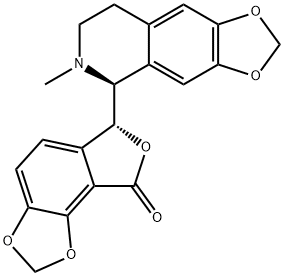(+)-Bicuculline
Synonym(s):Bucuculline
- CAS NO.:485-49-4
- Empirical Formula: C20H17NO6
- Molecular Weight: 367.35
- MDL number: MFCD00005006
- EINECS: 207-619-7
- SAFETY DATA SHEET (SDS)
- Update Date: 2024-12-18 14:08:52

What is (+)-Bicuculline?
Chemical properties
Pale Yellow Solid
The Uses of (+)-Bicuculline
Alkaloid naturally occurring in the d-form. Shows GABA antagonist activity.
The Uses of (+)-Bicuculline
GABAA receptor antagonist.
The Uses of (+)-Bicuculline
GABAa antagonist
What are the applications of Application
(+)-Bicuculline is a GABA A receptor antagonist
Definition
ChEBI: Bicuculline is a benzylisoquinoline alkaloid that is 6-methyl-5,6,7,8-tetrahydro[1,3]dioxolo[4,5-g]isoquinoline which is substituted at the 5-pro-S position by a (6R)-8-oxo-6,8-dihydrofuro[3,4-e][1,3]benzodioxol-6-yl group. A light-sensitive competitive antagonist of GABAA receptors. It was originally identified in 1932 in plant alkaloid extracts and has been isolated from Dicentra cucullaria, Adlumia fungosa, Fumariaceae, and several Corydalis species. It has a role as an agrochemical, a central nervous system stimulant, a GABA-gated chloride channel antagonist, a neurotoxin and a GABAA receptor antagonist. It is an isoquinoline alkaloid, a member of isoquinolines and a benzylisoquinoline alkaloid.
General Description
Bicuculline is a convulsant alkaloid. It was originally isolated from the plant Dicentra cucullaria.
Biological Activity
Classical GABA A antagonist.
Biochem/physiol Actions
(+)-Bicuculline acts as a competitive inhibitor of GABA liganding binding to the receptor.
Safety Profile
A poison by intraperitoneal route.When heated to decomposition it emits toxic vapors ofNOx.
storage
+4°C
Purification Methods
It crystallises from CHCl3/MeOH as plates. The crystals melt at 177o, then solidify and re-melt at 193-195o [Manske Canad J Research 21B 13 1943]. It is soluble in CHCl3, *C6H6, EtOAc but sparingly soluble in EtOH, MeOH and Et2O. [Stereochem: Blaha et al. Collect Czech Chem Commun 29 2328 1964, Snatzke et al. Tetrahedron 25 5059 1969, Pharmcol: Curtis et al. Nature 266 1222 1970, Beilstein 27 III/IV 1900].
Properties of (+)-Bicuculline
| Melting point: | 193-197 °C |
| Boiling point: | 497.92°C (rough estimate) |
| alpha | D25 +130.5° (CHCl3) |
| Density | 1.3694 (rough estimate) |
| refractive index | 1.5600 (estimate) |
| storage temp. | 2-8°C |
| solubility | Benzene, Chloroform, DMSO, Ethyl Acetate |
| pka | 4.84(at 25℃) |
| form | Off-white to yellow powder. |
| color | Pale Yellow |
| optical activity | [α]20/D +126±6°, c = 1% in chloroform |
| λmax | 325nm(lit.) |
| Merck | 14,1203 |
| BRN | 98786 |
| CAS DataBase Reference | 485-49-4(CAS DataBase Reference) |
| EPA Substance Registry System | Furo[3,4-e]-1,3-benzodioxol-8(6H)-one, 6-[(5S)-5,6,7,8-tetrahydro-6-methyl-1,3-dioxolo[4,5-g]isoquinolin-5-yl]-, (6R)- (485-49-4) |
Safety information for (+)-Bicuculline
| Signal word | Danger |
| Pictogram(s) |
 Skull and Crossbones Acute Toxicity GHS06  Environment GHS09 |
| GHS Hazard Statements |
H400:Hazardous to the aquatic environment, acute hazard |
| Precautionary Statement Codes |
P260:Do not breathe dust/fume/gas/mist/vapours/spray. P262:Do not get in eyes, on skin, or on clothing. P273:Avoid release to the environment. P280:Wear protective gloves/protective clothing/eye protection/face protection. |
Computed Descriptors for (+)-Bicuculline
| InChIKey | IYGYMKDQCDOMRE-ZWKOTPCHSA-N |
New Products
(S)-3-Aminobutanenitrile hydrochloride 4-Methylphenylacetic acid N-Boc-D-alaninol N-BOC-D/L-ALANINOL Tert-butyl bis(2-chloroethyl)carbamate 3-Morpholino-1-(4-nitrophenyl)-5,6-dihydropyridin- 2(1H)-one Furan-2,5-Dicarboxylic Acid Tropic acid 1-Bromo-3,5-Di-Tert-Butylbenzene S-2-CHLORO PROPIONIC ACID ETHYL ISOCYANOACETATE 2-Bromo-1,3-Bis(Dimethylamino)Trimethinium Hexafluorophosphate 4-IODO BENZOIC ACID 3-NITRO-2-METHYL ANILINE 1-(2,4-DICHLOROPHENYL) ETHANAMINE (2-Hydroxyphenyl)acetonitrile 4-Bromopyrazole 2-(Cyanocyclohexyl)acetic acid 4-methoxy-3,5-dinitropyridine 1-(4-(aminomethyl)benzyl)urea hydrochloride 2-aminopropyl benzoate hydrochloride diethyl 2-(2-((tertbutoxycarbonyl)amino) ethyl)malonate tert-butyl 4- (ureidomethyl)benzylcarbamate Ethyl-2-chloro((4-methoxyphenyl)hydrazono)acetateRelated products of tetrahydrofuran








You may like
-
 (+)-Bicuculline CAS 485-49-4View Details
(+)-Bicuculline CAS 485-49-4View Details
485-49-4 -
 (+)-Bicuculline CAS 485-49-4View Details
(+)-Bicuculline CAS 485-49-4View Details
485-49-4 -
 1975-50-4 98%View Details
1975-50-4 98%View Details
1975-50-4 -
 2-HYDROXY BENZYL ALCOHOL 98%View Details
2-HYDROXY BENZYL ALCOHOL 98%View Details
90-01-7 -
 2-Chloro-1,3-Bis(Dimethylamino)Trimethinium Hexafluorophosphate 221615-75-4 98%View Details
2-Chloro-1,3-Bis(Dimethylamino)Trimethinium Hexafluorophosphate 221615-75-4 98%View Details
221615-75-4 -
 61397-56-6 CIS BROMO BENZOATE 98%View Details
61397-56-6 CIS BROMO BENZOATE 98%View Details
61397-56-6 -
 14714-50-2 (2-Hydroxyphenyl)acetonitrile 98+View Details
14714-50-2 (2-Hydroxyphenyl)acetonitrile 98+View Details
14714-50-2 -
 118753-70-1 98+View Details
118753-70-1 98+View Details
118753-70-1